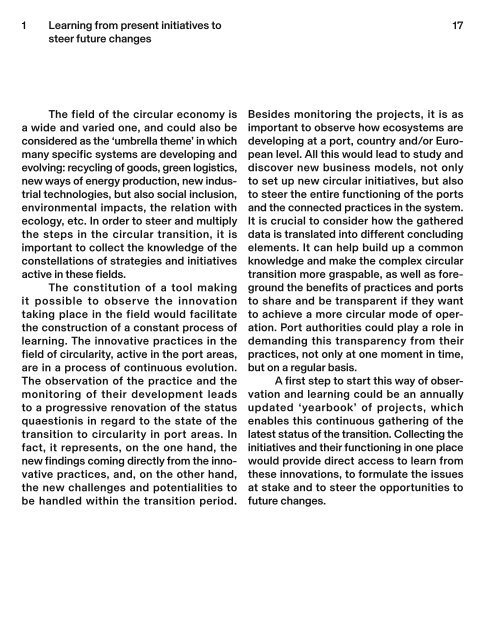Circular (City) Ports_Shaping Future Changes
- No tags were found...
Create successful ePaper yourself
Turn your PDF publications into a flip-book with our unique Google optimized e-Paper software.
1 Learning from present initiatives to<br />
steer future changes<br />
17<br />
The field of the circular economy is<br />
a wide and varied one, and could also be<br />
considered as the ‘umbrella theme’ in which<br />
many specific systems are developing and<br />
evolving: recycling of goods, green logistics,<br />
new ways of energy production, new industrial<br />
technologies, but also social inclusion,<br />
environmental impacts, the relation with<br />
ecology, etc. In order to steer and multiply<br />
the steps in the circular transition, it is<br />
important to collect the knowledge of the<br />
constellations of strategies and initiatives<br />
active in these fields.<br />
The constitution of a tool making<br />
it possible to observe the innovation<br />
taking place in the field would facilitate<br />
the construction of a constant process of<br />
learning. The innovative practices in the<br />
field of circularity, active in the port areas,<br />
are in a process of continuous evolution.<br />
The observation of the practice and the<br />
monitoring of their development leads<br />
to a progressive renovation of the status<br />
quaestionis in regard to the state of the<br />
transition to circularity in port areas. In<br />
fact, it represents, on the one hand, the<br />
new findings coming directly from the innovative<br />
practices, and, on the other hand,<br />
the new challenges and potentialities to<br />
be handled within the transition period.<br />
Besides monitoring the projects, it is as<br />
important to observe how ecosystems are<br />
developing at a port, country and/or European<br />
level. All this would lead to study and<br />
discover new business models, not only<br />
to set up new circular initiatives, but also<br />
to steer the entire functioning of the ports<br />
and the connected practices in the system.<br />
It is crucial to consider how the gathered<br />
data is translated into different concluding<br />
elements. It can help build up a common<br />
knowledge and make the complex circular<br />
transition more graspable, as well as foreground<br />
the benefits of practices and ports<br />
to share and be transparent if they want<br />
to achieve a more circular mode of operation.<br />
Port authorities could play a role in<br />
demanding this transparency from their<br />
practices, not only at one moment in time,<br />
but on a regular basis.<br />
A first step to start this way of observation<br />
and learning could be an annually<br />
updated ‘yearbook’ of projects, which<br />
enables this continuous gathering of the<br />
latest status of the transition. Collecting the<br />
initiatives and their functioning in one place<br />
would provide direct access to learn from<br />
these innovations, to formulate the issues<br />
at stake and to steer the opportunities to<br />
future changes.


















